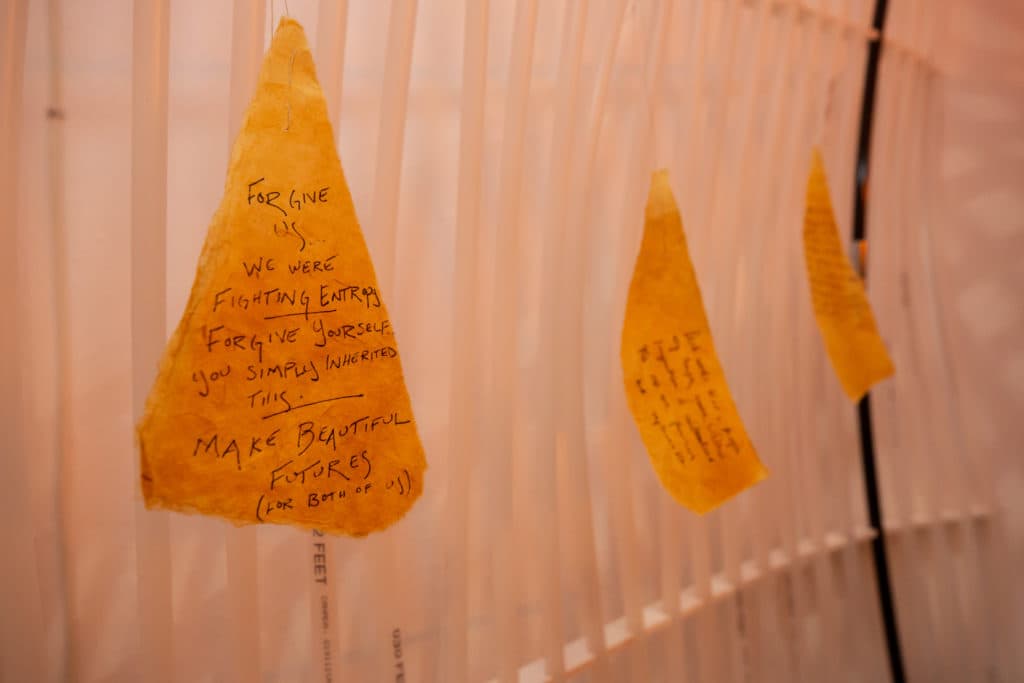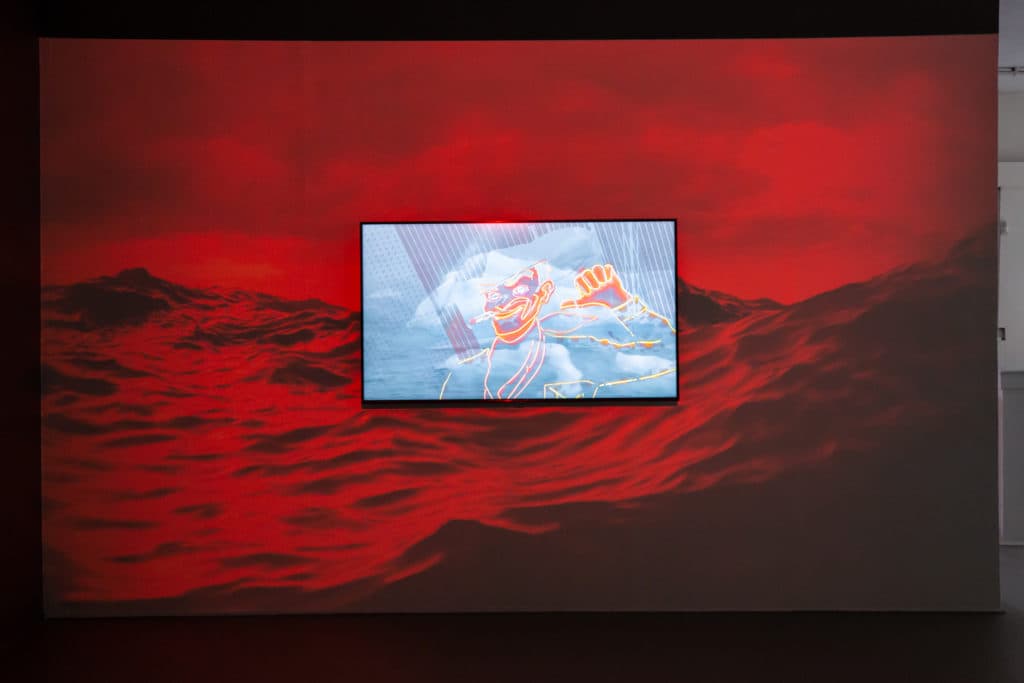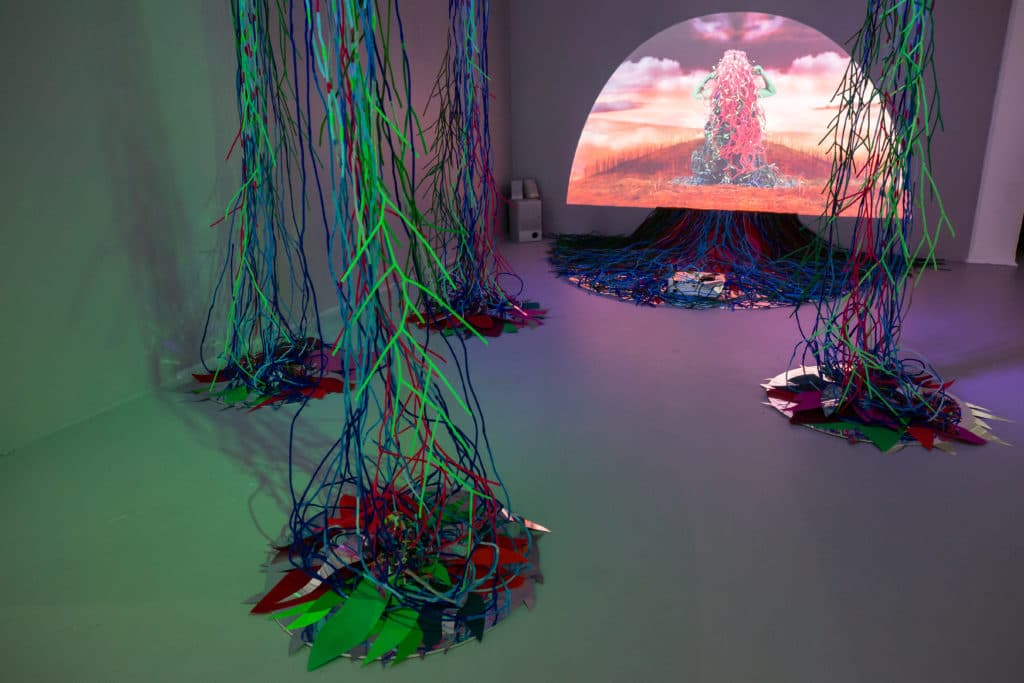I write this review from the same place I viewed Boston Center for the Arts’ current exhibition, “FeministFuturist”—my living room. I am fortunate to be working from home, but I was not fortunate enough to see the exhibition in person before strict social distancing orders were set in place across the country. My understanding of the exhibition cannot be separated from the sense of collective grief at this moment. The pressure to maintain some form of business-as-usual as we move much of our lives online tempts us to ignore the monumental feeling of loss that comes with no longer being physically present—both in a space and with one another. This perspective colors my experience of “FeministFuturist” as well.
With “FeministFuturist” slated to run from February 8 to April 5, BCA staff sensed the urgency of the moment as decisions were being made to close institutions around the city and quickly worked to transpose the exhibition online.
Curators Carolyn Wirth and Karen Meninno collaborated on bringing together a confluence of distinct voices that consider how feminism can investigate major issues facing us today and how a robust feminist framework can equip us for the potential realities ahead. Online, it is easy to miss the full “vitality” of the artists’ visions as described to me by BCA’s Director of Visual Arts, Randi Hopkins, and Artistic Associate, Andrew Grimanis. Hopkins noted that the staff, curators, and artists reveled in dreaming up this space—it had an “inner life” that stemmed from the way the objects spoke to one another in the Mills Gallery. Grimanis pointed out the sensory overload native to the exhibition—from the sounds of multiple videos playing at once to the interactivity of the installations—is an element they could not recreate. In turn, BCA staff leaned on their trove of exhibition photography to give “FeministFuturist” a digital life.
The original exhibition was a gathering of women artists’ voices presented in the form of video, installation, sculpture, clothing, photographs, and collage. It also provided visitors space to process and relax in a lounge area that housed a library for further feminist reading. This online iteration of “FeministFuturist” shakes itself from traditional physical representation and feels very contemporaneous—in true feminist fashion, it perseveres. Both versions share the sentiment that there is no singular feminism or feminist.

Freedom Baird, Instructions Vault, detail view, 2020. Photo by Melissa Blackall.
Some pieces translated well as they took on new forms. Grimanis worked closely with artist Freedom Baird to move “Instructions Vault” from its own room within the gallery to the web. Originally offering pieces of Nepalese Lokta paper to write their instructions for possible futures, visitors are now asked to “inscribe” them in a Google form. They are primed with questions asking who will be there, what will be happening, and what will be needed. BCA then posts these instructions on the exhibition page.
Baird’s request of us feels difficult to contend with presently. It can feel almost impossible to think beyond the current day, let alone to an abstract idea of the future. But eventually, the mind starts to wander to what life might look like immediately after we are allowed outside of our six-foot bubbles. Or even beyond that. Both iterations of Baird’s work urge us to look outside of the present moment, past the limitations before us. Now seems as appropriate a time as any to envision a better world.

Magda Fernandez, Untitled, 2020. Two-channel HD video (color, no sound), 3:15 min. Courtesy of the artist.
In comparison to “Instruction Vault,” Magda Fernandez’s “Untitled” delivers a stark awakening. Online, we see one video—a series of familiar scenes of Boston superimposed on disaster reels, layered on top of a threatening red ocean. In the gallery, it appeared to take up an entire wall. Fernandez’s work centers on the idea of a disastrous threat of climate change. She seeks to elicit the feeling of dread and fear in order to drive collective action. As the first work we encounter after the online introduction, “Untitled” is a portal into feminist truth-telling. Fernandez believes “feminism is about telling the truth, no matter the resistance,” grounding her work in a very possible future.
Meanwhile, Linda Price-Sneddon’s “S/H/E Emergent” is a window into an ethereal world. The video tells the story of S/H/E (Spirit Healing Entity) who seeks to balance the feminine and masculine aspects of Being. Price-Sneddon draws from the culture of the Ohio River Valley Hopewell Indians, whose culture was heterarchical, bringing balance between women and men. This narrative draws on a very binary and traditional view of gendered energy, but the notion of a balance that turns competing sides into cohesive ones is alluring. The mysterious S/H/E is introduced on a burial mound in a rather barren landscape, ultimately bringing about a lush green world. In the Mills Gallery, “S/H/E Emergent” played in a cove of its own, with chenille pipe cleaners descending from the ceiling like multi-colored veins—we are reminded of the loss of vibrancy and movement that Hopkins and Grimanis mention. While you cannot help but think that part of Price-Sneddon’s storytelling is lost, the video stands on its own in this new form, commanding the viewer’s attention.

Linda Price-Sneddon, S/H/E Emergent, installation view, 2020. Photo by Melissa Blackall.
To close out the show, BCA transformed the idea behind its lounge space into a selected reading list. This ending resonated with me—for many of us with nowhere to be, what better time to pick up a book? The handpicked novels and story collections serve as a bridge between the physical exhibition and its online counterpart, extending the themes of “FeministFuturist” beyond this single interaction and offering additional perspectives.
One of the critical questions I asked myself was whether this version of the exhibition does it justice. The short answer is obviously no—but it is complicated. Besides the difference in format, this adaptation does not reflect the labor behind a traditional exhibition. We know that seeing a photo of “Instructions Vault” is not the same as being in the works’ presence. But it does underscore the adaptability and necessity of cultural institutions within our city in the midst of crisis. They offer us an escape, community, and space to think critically in dismal times.

Karen Meninno and Carolyn Wirth, K-space Lounge, installation view, 2020. Photo by Melissa Blackall.
At this moment, we are seeing calls for kindness, empathy, and compassion. Caretakers are celebrated as we take care of ourselves, our loved ones, communities, and neighbors. It is simultaneously empowering to see and disheartening to know that these stereotypical “feminine” characteristics are often what hold women back in our patriarchal society. “FeministFuturist” demonstrates that feminism can take on many forms, mean different things, and be embodied by different people. The curators tell us in the show’s wall text, “Women artists are now uniquely poised to be cultural powerbrokers whose viewpoints on the future of society and the planet shape the world stage itself, instead of merely filling seats in the audience.” I would extend this to women in general. This pandemic has the potential to shape the futures on the other side of it—perhaps now is the best time to begin thinking about the ways in which the world is shifting beneath us and how the progress made up to this moment can bring significant social and political change. We cannot forget how traditionally feminine characteristics stood for strength, resiliency, and hope once we are past this immediate crisis. There is still much more work to be done on this front, but perhaps this can be a foothold to a brighter chapter.
“FeministFuturist” includes work by Freedom Baird, Amy Borezo, Nadine Boughton, Linda Leslie Brown, Marisa Chentakul, Julia Daviy, Magda Fernandez, KSpace (Karen Meninno and Carolyn Wirth), Brenna Leaver, AK Liesenfeld, Linda Price-Sneddon and Genevieve Quick.
The digital exhibition can be viewed on Boston Center for the Arts’ website here.





